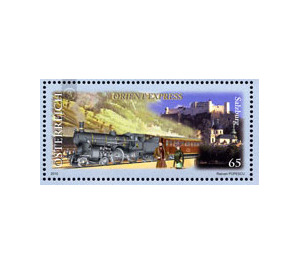Orient express - Austria / II. Republic of Austria 2010 - 130 Euro Cent
Theme: Traffic, Transportation & Mobility
| Country | Austria / II. Republic of Austria |
| Issue Date | 2010 |
| Face Value | 130.00 |
| Edition Issued | 170,000 |
| Printing Type | offset |
| Stamp Type | Commemorative |
| Item Type | Stamp |
| Chronological Issue Number | 2225 |
| Chronological Chapter | OOS-OE2 |
| SID | 14854 |
| In 23 Wishlists | |
The present brand block represents a philatelic premiere, as it is the first joint issue of Austria and Romania. The chosen theme is "Orient Express", the legendary rail link that once connected the two countries in a very luxurious way. The attractive block motif shows in the background a map showing the corresponding route, the Parisian East Railway Station, the Giant Ferris Wheel and the famous mosque "Hagia Sofia" of Istanbul, the lettering "Orient Express" and the imposing railway sign. The two brand images themselves each show historic locomotives of the Orient Express as well as the two transit cities of Salzburg and the former royal summer residence Sinaia in Romania. History: In the period up to the Second World War, the Orient Express was a luxury train of the "Compagnie Internationale des Wagons-Lits", which linked Paris and Constantinople (today's Istanbul). It was written June 5, 1883, when it first drove east from Paris East Station - a feudal first-class hotel train with saloon, sleeping and dining cars. In the first years, the trip ended in the Romanian city of Giurgiu, travelers to Constantinople had to cross the Danube by ferry, travel on a normal train to Varna and take from there the ship. Only from 1888 reversed the Orient Express throughout Budapest, Belgrade and Sofia to Constantinople Opel. The travel time on the 3,186 kilometer route was almost 70 hours, there were local food and various folklore performances to entertain the well-heeled passengers. The Orient-Express became known not only for its luxury and the public of the European high and financial aristocracy, but also for some spectacular events. Thus, in 1891, a Greek robber derailed the train west of Constantinople, abducted four men, and released them only after a considerable ransom had been paid. A few years later, an envoy from the French government was murdered in his compartment, and even in 1950, the railroad was at that time a normal D-train, a US military attaché was attacked and robbed by Eastern Bloc agents. After a changeful history in the past decades, only a small part of this legendary connection on the Strasbourg - Vienna route has recently been reversed; In December 2009, however, this route was canceled, which meant the final out for the Orient Express. Of course, various novels and famous films contributed not insignificantly to the fame of this procession. Representing many others are Agatha Christie's "Murder on the Orient Express" and the James Bond movie "Greetings from Moscow".


